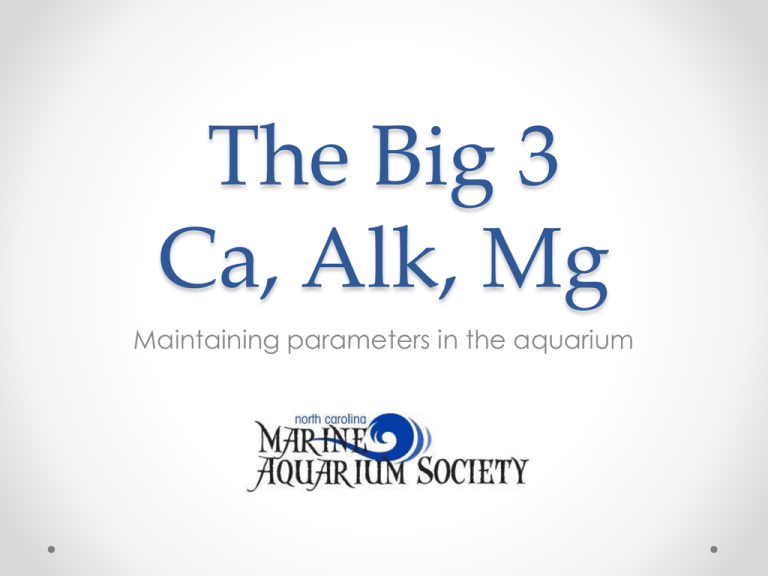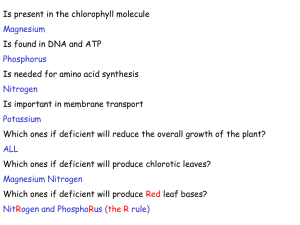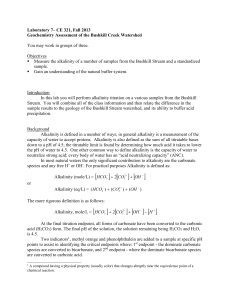The Big 3 Ca, Alk, Mg
advertisement

The Big 3 Ca, Alk, Mg Maintaining parameters in the aquarium Calcium • Used by corals to build hard skeleton base o Corals need calcium carbonate to build their skeletons • Used mostly by SPS and LPS corals and hard algae (coralline) • Proper range in the aquarium: 400ppm to 450ppm • STABILITY IS KEY • Can be tested with most commercial test kits o API, Salifert, Hanna, Red Sea… Alkalinity • Total alkalinity is defined as the amount of acid required to lower the pH of the sample to the point where all of the bicarbonate [HCO3-] and carbonate [CO3--] could be converted to carbonic acid [H2CO3] – Randy Holmes-Farley http://www.advancedaquarist.com/2002/2/chemistry Alkalinity • An indirect measurement of the amount of carbonate in the aquarium • Used by all corals along with calcium to build their skeletal structures • Proper range in the aquarium: 8dKh to 10dKh o 2.86 meq/l to 3.57 meq/l • Can be tested with most commercial test kits o API, Salifert, Hanna, Red Sea… • Works inversely with calcium o As alkalinity goes up, calcium goes down unless a proper balance is kept Alkalinity • If alkalinity gets too high too quickly it will precipitate calcium in the water o Looks like it is snowing in the aquarium • STABILITY IS KEY!!! o It takes months for corals to adapt to new alkalinity so rapid changes can cause Rapid Tissue Necrosis (RTN), Slow Tissue Necrosis (STN), or slow/no growth Magnesium • Used by all life in the aquarium • Helps maintain a proper balance between Alkalinity and Calcium • Higher magnesium prevents alkalinity and calcium “swings” in the aquarium • Proper range in the aquarium: 1350ppm to 1450ppm • Higher Mg can cause Calcium to be “super saturated” in the tank o This is a good thing! o More calcium and more Alkalinity leads to better coral growth Maintenance • It is VERY important to maintain proper and stable levels to having a thriving reef • There are numerous ways to maintain these values o Frequent water changes o Calcium Reactor o Dosing Water Changes • Used in a low demand tank (few LPS and SPS corals) • Can be done daily (automatically) to maintain any tank • Pros o Helps stability in the tank o Other bad stuff is removed during a water change o Adds other trace elements needed by all life • Cons o Too much time! o Tedious • When doing water changes make sure your new water has the correct levels of these 3 components o Not testing the new water can lead to low levels over time Calcium Reactor • A way to “recycle” coral skeletons back into the system • Media is dissolved in low pH water to replenish all elements needed by corals • Pros o Keeps Alk and Ca at proper levels o “Set it and forget it” o Low maintenance once it is up and running • Cons o Normally only for larger tanks 75+ gallons (smaller tanks may have low pH issues) o Reactor failure can kill your entire tank o Initial setup can be tricky and frustrating o Many people use Kalkwasser to offset low pH issues o May still need to dose for Magnesium in high demand tank Dosing • Maintains proper levels by adding pre-mixed chemicals to aquarium • Calcium – Calcium Chloride • Alkalinity – Sodium Carbonate o Baking Soda • Magnesium – Mg Sulfate, Mg Chloride or a combo o Espom Salts o Adding too much may raise the salinity of the tank, so be sure to test • Various companies make pre-mixed 2-part products o Some contain more than just Ca and Alk which may help other areas • Can be added manually each day or use a mechanical doser to automate Dosing • Pros o Finer control over all 3 parameters o When done with a doser, parameter remain very stable o When using a doser, chemicals can be added in small amounts 24 times a day limiting swings in parameters o Wider variety of dosers on the market now so prices will come down • Cons o o o o o o o When done manually parameters may vary too much When done manually precise measurements are difficult Doser requires regular maintenance to verify it is still working properly Chemical containers need to be refilled monthly Chemicals can become costly over time Accidental over-dosing can cause huge problems Determining amount to dose can be tedious in the beginning Dosing • Determining how much to dose o Be sure parameters in the aquarium are at normal levels • If not, add chemicals manually until they are correct o Wait 3 days, don’t add any chemicals to the tank o Test all 3 parameters o Using a reef calculator determine how much chemical you will need to add o Divide that amount by 3. This is how much you will need to dose each day o After 1 week re-test all 3 parameters and verify they are still correct • Modify doser settings as needed Dosing • Tips and Tricks o Do not dose both parts at the same time • This can cause calcium to precipitate out of the water o Do not dose both parts in the same area of the tank • Do not dose near a return pump o Split dosing up to small increments to limit alkalinity and pH spikes o Check the doser after each water change to verify it is still working properly and doesn’t need maintenance • Tubing isn’t clogged • Check valves still work properly (if used) How To: Dosing Two Part in Your Reef Tank










